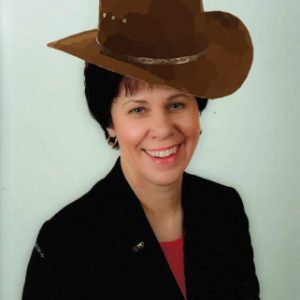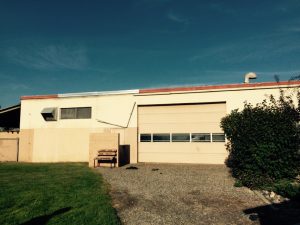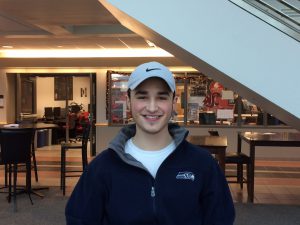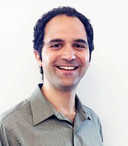A TRIO OF TRIUMPHS NEAR THE TRI-CITIES: VISITING THE MID-COLUMBIA STEM NETWORK
That’s not a comment on the size of the cranium of Deb Bowen, Executive Director of the Mid-Columbia STEM Network. It’s an analogy that Deb uses to describe the role that she helps the Mid-Columbia STEM Network play in her community.

Deb Bowen, Mid-Columbia STEM Network Director. It might be hard to believe, but this image is photoshopped.
The Mid-Columbia STEM Network supports the connection of K-12 STEM education, higher education, community, government, and business interests to work together as a “really big hat” to support student exploration of STEM education and career opportunity. Mid-Columbia STEM Network members create cross-sector connections that in turn create funding, possibility, and projects in the Tri-Cities and surrounding areas. When I visited the STEM Network last week, I got to see just three of the many bright spots of the Mid-Columbia STEM Network. Here’s my story.
Beyond the Bus Barn: River View High School in Finley, Washington
Imagine studying science in a huge, drafty, dusty, garage originally built in the 70s to house buses. In the winter it gets cold, in the summer it gets hot. Are you sweating in your goggles and lab coat yet? That physical space is a daily reality for the students of River View High School in rural Finley, Washington. Students make the most of the space and many graduate with a passion for agricultural science in particular thanks to the amazing teachers who run the outstanding agricultural tech and 4H programs at River View. Yet it’s far from an ideal space.

The bus garage of River View High School.
So, that’s where the Mid-Columbia STEM Network comes in. Members of the Mid-Columbia STEM Network saw a real need for funding to improve teaching and learning spaces for STEM. STEM Network members traveled with Washington STEM to Olympia to speak with their legislators about the need for improved spaces. After many meetings, discussions, and negotiations – success. The Legislature recognized that a student’s STEM learning improves exponentially with access to modern facilities and updated equipment. They funded the STEM Capital Grants program and the Finley School District applied and was selected for a capital upgrade. Finley worked hard to secure a private match and expects to break ground in April on new career technical education classrooms, including a 3-D printing space and bio tech lab.
Opportunity Knocks: Washington State Opportunity Scholarship in the Tri-Cities

WSOS scholar Abraham Mendoza.
My next stop in the Tri-Cities was to the Washington State University Tri-Cities campus to meet first year student Abraham Mendoza. Abraham’s schooling has been funded in part by a Washington State Opportunity Scholarship (WSOS) – a scholarship created by the State Legislature and private partners to help low- and middle-income Washington state residents earn their bachelor’s degrees in the high- demand fields of STEM and health care.
“My dad comes from Colima, Mexico. He would have gone to college but he never had the opportunity. He did have the motivation, and he passed that on to me.” Abraham explained. Abraham’s going to college to explore his passions in solar energy and entrepreneurship. His interest in STEM fields was sparked through his studies at the public STEM school operated by the Pasco, Kennewick, and Richland School Districts – Delta High School. He shared that his teachers supported his achievement at science fairs, in the classroom, and now in college.
Abraham further explained that WSOS offered support beyond money. He went to a WSOS orientation event in Seattle where he learned what to expect in college, and also met one of his role models: philanthropist and entrepreneur Gary Rubens. “I was nervous to approach Gary, but he said during his speech ‘if you see an opportunity, go for it,’ and so I went for it and talked to him. We’ve e-mailed lately and he is an awesome guy who shares his honest opinions with me about my future plans.”
The Mid-Columbia STEM Network has played a big role in making sure that students like Abraham have access to the Washington State Opportunity Scholarships. In January, the STEM Network hosted a training for representatives from every interested high school in the area to let them know about the Washington State Opportunity Scholarships and how to apply. This training resulted in a 300 percent increase in the number of WSOS applications over the prior year and $1,080,000 in scholarships being awarded within the Network. I asked Abraham if he knew anyone else who was planning on applying for the scholarship. He said that his sister, a high school senior who wants to be a doctor or nurse, “better apply!”
Next Stop: The New STEAM Middle School
Richland STEAM (science, technology, engineering, arts, and math) Middle School #4 just held a public competition for a new name. There were a few ballots cast for Hogwarts and one for “Smarty Pants Middle School,” but most of the community suggestions have been thoughtful and reflective of the values of the up-and-coming STEAM Middle School.

STEAM Middle School #4 Planning Principal Andrew Hargunani.
Planning Principal Andre Hargunani moved from Los Angeles, where he operated an innovative STEM high school focused on computer science and gaming, to lead the way in opening this STEM school. He’s working closely with community core teams to ensure that everything about the school – from the mission to the curriculum, down to the school colors – is reflective of the Tri-Cities community.
“I’m including STEM industry professionals in discussions from the very beginning. They look at science standards and ask ‘how is that related to what I’m working on over at Hanford Observatory?’” says Andre. From there, educators build lessons where industry professionals can work with students to give active feedback about the work. What Andre really hopes is “that we are successful in starting to transform education to be really relevant to the careers in the community. That there’s not this disconnect, that students don’t ask ‘why am I learning what I’m learning? What does this have to do with anything?’”
The new STEAM middle school will open in Fall 2017. Until it does, find out what’s happening here.
Join the Mid-Columbia STEM Network
What’s a good analogy instead of “tip of the iceberg?” that would be regionally appropriate to the Tri-Cities? Let’s go with “grape in the vat.” These three bright spots are just a “grape in the vat” of all of the projects that the Mid-Columbia STEM Network is offering. Want to find out more? Check out the organization running the Mid-Columbia STEM Network, the Washington State STEM Education Foundation. They’re always looking for volunteers and donations!
